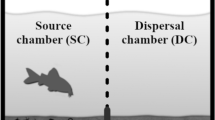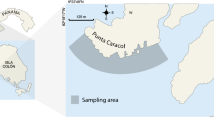Synopsis
Armored catfish, Ancistrus spinosus, graze substrates in a central Panamanian stream. They ingest both attached algae and sediment that settles onto substrates. During the dry season, this sediment is organic-rich (18–24% ash-free dry weight), and is derived from decomposing periphyton and vegetation from the surrounding, largely deciduous forest. This sediment, however, is not a food for Ancistrus, and in fact imposes energetic costs. These costs were estimated to be 15–22% of the daily energy budgets of 10 g individuals held under experimental conditions. In the stream, the presence of thick sediment on substrates increases the tendency for small Ancistrus to seek out larger individuals or areas cleared by them. Clearing of substrates by larger individuals may be particularly important to smaller Ancistrus during the dry season, when sediment-free substrate in stream pools is in short supply.
Similar content being viewed by others
References cited
Avinmelech, Y., B.W. Troeger & L.W. Reed. 1982. Mutual flocculation of algae and clay: evidence and implications. Science 216: 63–65.
Bartholomew, G.A. 1977. Energy metabolism. pp. 57–110. In: M.S. Gordon (ed.) Animal Physiology, Macmillan, New York.
Bowen, S.W. 1981. Digestion and assimilation of periphytic detrital aggregate by Tilapia mossambica. Trans. Amer. Fish. Soc. 110: 239–245.
Bowen, S.H. 1979. A nutritional constraint on detritivory by fishes: the stunted population of Sarotherodon mossambicus in Lake Sibaya, South Africa. Ecol. Monogr. 49: 17–31.
Bowen, S.H. 1976. Mechanism for digestion of detrital bacteria by the cichlid fish Sarotherodon mossambicus (Peters). Nature 260: 137–138.
Brett, J.R. & T.D.D. Groves. 1979. Physiological energetics. pp. 279–352. In: W.S. Hoar, D.J. Randall & J.R. Brett (ed.) Fish Physiology, Vol 8, Academic Press, New York.
Clarke, P.J. & F.C. Evans. 1954. Distance to nearest neighbors as a measure of spatial relationships in populations. Ecology 35: 445–453.
Cummins, K.W. 1975. Macroinvertebrates. pp. 170–198. In: B.A. Whitton (ed.) River Ecology, Univ. Calif. Press, Berkeley.
Freeland, W.J. & D.H. Janzen. 1974. Strategies in herbivory by mammals: The role of plant secondary compounds. Amer. Natur. 108: 269–289.
Herbert, D.W.M. & J.C. Merkins. 1961. The effect of suspended mineral solids on the survival of trout. Int. J.. Air Wat. Poll. 5: 46–55.
Hiatt, R.W. & D.W. Strasburg. 1960. Ecological relationships of the fish fauna on coral reefs of the Marshall Islands. Ecol. Monogr. 30: 65–127.
Kramer, D. L. 1983. The evolutionary ecology of respiratory mode in fishes: an analysis based on the cost of breathing. Env. Biol. Fish. 9: 145–158.
Lagler, K.F. 1956. Freshwater fishery biology. Brown, Dubuque. 421 pp.
Lautenschlager, K.P., N.K. Kaushik & J.B. Robinson. 1978. The peritrophic membrane and faecal pellets of Gammarus lacustris Smith. Freshwater Biology 8: 207–211.
MacLoed, J.C . & L.L. Smith, 1966. Effect of pulpwood fiber on oxygen consumption and swimming endurance of fathead minnow Pimephales promelas. Trans. Amer. Fish. Soc. 95: 71–84.
Mechtly, E.A. 1973. The international system of units. Physical constants and conversion factors. Scientific and Technical Information Office, Natural Aeronautics and Space Administration, Washington, D.C..
Miller, H.C. 1964. The behavior of the pumpkinseed sunfish, Lepomis gibbosus (Linnaeus) with notes on the behavior of other species of Lepomis and the pygmy sunfish, Elassoma evergladei. Behaviour 22: 88–151.
Odum, W.E. 1970. Utilisation of direct grazing and plant detritus food chains by the striped mullet, Mugil cephalus. pp. 222–240. In: J.H. Steele (ed.) Marine Food Chains, Univ. Calif. Press, Berkeley.
Odum, W.E. 1968. The ecological significance of fine particle selection by the striped mullet Mugil cephalus. Limnol. Oceanoar. 13: 92–98.
Ogden, J.C. & P.S. Lobel. 1978. The role of herbivorous fishes and urchins in coral reef communities. Env. Biol. Fish. 3: 49–63.
Payne, A.I. 1978. Gut pH and digestive strategies in estuarine grey mullet (Mugilidae) and tilapia (Cichfidae). J. Fish Biol. 13: 627–630.
Power, M.E. 1981. The grazing ecology of armored catfish (Loricariidae) in a Panamanian stream. Ph.D. dissertation, Univ. Washington, Seattle. 268 pp.
Schmidt-Nielsen, K. 1975. Animal physiology: Adaptation and environment. Cambridge Univ. Press, Cambridge. 560 pp.
Shul'man, G.E. 1974. Life cycles of fish: physiology and biochemistry. Wiley, New York, 258 pp.
Siegel, S. 1956. Nonparametric statistics for the behavioral sciences. McGraw-Hill, New York. 312 pp.
Smith, L.L., R.H. Kramer & D.M. Oseid. 1966. Long-term effects of conifer groundwood paper fibre on walleyes. Trans. Amer. Fish. Soc. 95: 60–70.
Westoby, M. 1974. An analysis of diet selection by large generalist herbivores. Amer. Natur. 108: 290–304.
Wilbur, H.M. 1977. Density-dependent aspects of growth and metamorphosis in Bulo americanus. Ecology 58: 196–200.
Author information
Authors and Affiliations
Rights and permissions
About this article
Cite this article
Power, M.E. The importance of sediment in the grazing ecology and size class interactions of an armored catfish, Ancistrus spinosus . Environ Biol Fish 10, 173–181 (1984). https://doi.org/10.1007/BF00001124
Received:
Accepted:
Issue Date:
DOI: https://doi.org/10.1007/BF00001124




